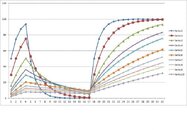You are stuck with the general definition also. so on the first dive of the day it is hard ti visualize how the fastest compartment will not be the controlling one when talking about NDL. The fastest compartment should be the only one to be able to first reach that level.
NDL is the time at which you can no longer directly ascend to the surface. In the dissolved gas models that is when ANY compartment reaches a inert gas partial pressure which would (probably) cause DCS at the surface given an ascent at however m/s the model designer chooses.
I am trying to show that which compartment is first to limit is non trivial and no general intuitive rule covers it.





